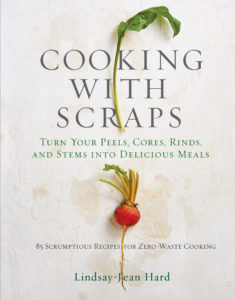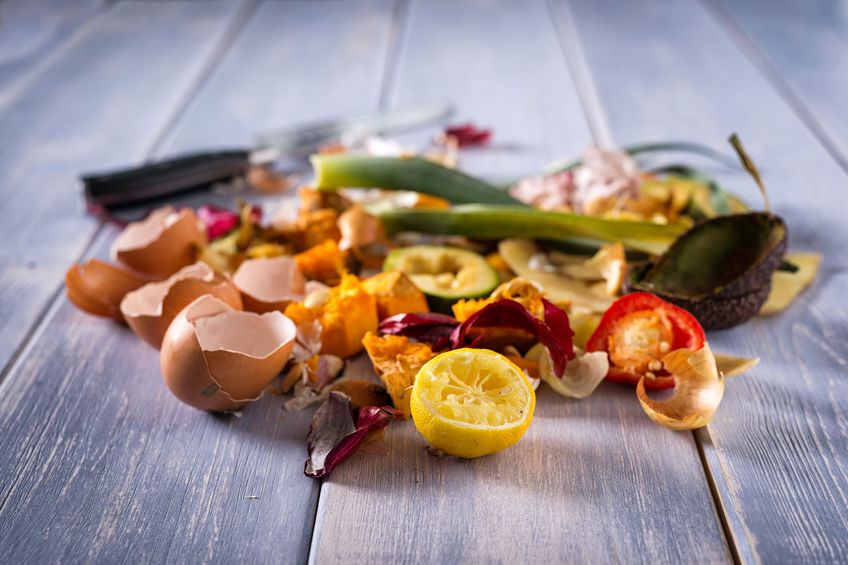Nearly 40 percent of the food in the United States is never eaten, according to the Natural Resources Defense Council. At the same time this food goes unused, one in eight Americans struggles to put enough food on their table. What’s the disconnect that makes our current system of food consumption so wasteful and inefficient? Many believe it’s due to food scraps not being used to its full potential—in essence to its entirety. Author of Cooking With Scraps: Turn Your Peels, Cores, Rinds, and Stems Into Delicious Meals, Lindsey-Jean Hard certainly agrees. She recently spoke with WellWell on her ongoing fight to reuse food waste and end the stigma of cooking with food scraps and leftovers, while defending their supreme edibility.
Why is food waste such an important issue and what are the main causes of it?
We are currently throwing away 40% of food in the United States and that’s happening at every stage of the process from farms and factories to transportation to grocery markets. But the biggest problem is us, the consumers. We’re throwing away a bigger percentage than grocery stores and restaurants combined. That’s really disheartening but it’s also really encouraging because it means we have the power to make a dent in those numbers.
According to the USDA, food insecurity affects 40 million Americans, what do you think it is about America specifically that has led to such a large amount of food waste?
I think a lot of us in this country are in a position of privilege where we don’t have to think about food waste. If a recipe tells us to cut off and discard the kale stems, we’ve been able to do that without thinking about it. However, we’ve reached the point now where we really need to think about it and need to reassess what is edible to make a difference by not throwing away all this perfectly good food.
How do we go about doing that, do you think?
The first step is just learning what is edible in what we’ve been throwing away. Some things that are easy to start with are stale bread or the top leafy greens from root vegetables like beets, radishes and carrots. Then once you start using more of these scraps and realizing that they’re just ingredients by working them into your regular routine, you can branch out from there and start putting to use more of the uncommon ones like coffee grounds or banana peels.
What types of food waste recipes can we make with coffee grounds?
Coffee grounds still have a lot of that coffee flavor left in them when you’re done with it. I’ve used them in nut butter, blending them in so to still get the coffee flavor in addition to the nuts and you get a nice little texture. But you can also use it in other ways too. I have a food waste recipe for a French silk pie that uses coffee grounds a couple of different ways. I’ve used it in crust for pie along with some chocolate cookies or even infused with cream so to get the coffee flavor in the whipped cream topping of the pie.
In your book, there are a lot of dishes and items that people may be surprised you would be able to make with scraps, such as the beet peel margarita. Are there any other alcoholic drinks or things of that nature that might surprise people scraps can be used for?
The beet peel margarita is one of my favorite ones in the book and I love how much of that beet flavor comes through in the tequila. You easily can infuse alcohols, waters and vinegars with a lot of scraps in the same manner to get a stronger flavor. One that’s really surprising to people is the banana peel cake. I don’t think that many people realize banana peels are not only edible but also taste delicious.
Do banana peels have the same nutrients as bananas?
It definitely does have nutrients in it, especially the fiber. But anytime that you’re using a peel, I would recommend buying organic or you may accidentally inhale some chemicals depending on the growing practices.
These techniques for using peels, stem and roots could benefit people in lesser food secure countries?
I think that a lot of other countries are probably better at this in general and people that might not be in as high of a socio-economic level already have to do this and therefor don’t need to be told to use the methods. But I think that generally everyone can benefit from being more thoughtful about getting the most out of our food.
So, are we making any progress on using scraps and leftovers more efficiently?
It’s slow going but there seems to be a growing awareness of the potential in scraps and leftovers. I think we just have to continue to educate people and make food conversation trendy.
 About Lindsey-Jean Hard
About Lindsey-Jean Hard
Lindsay-Jean Hard received her master’s degree in urban planning from the University of Michigan. Her education and passion for sustainability went on to inform and inspire her work in the garden, home, and community. Today she works to build and connect new communities as a food editor and writer. The seeds of this book were planted in her Food52 column of the same name. She lives, writes, loves, and creates in Ann Arbor, Michigan.












